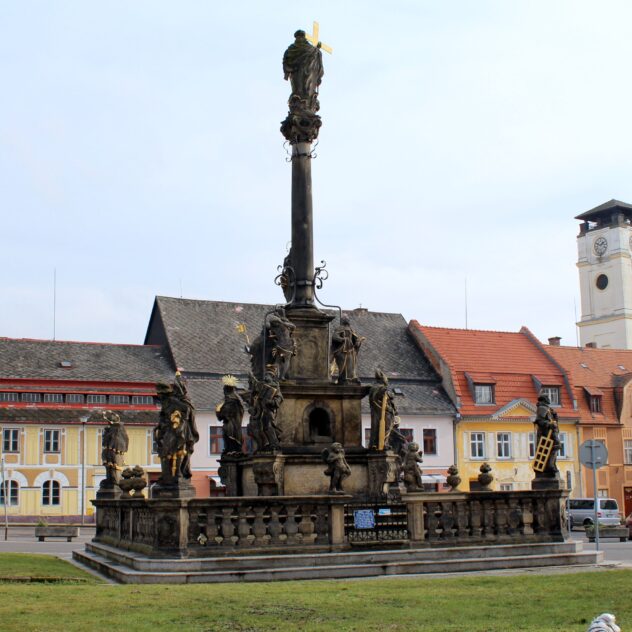Jablonné v Podještědí
Information about the pilgrimage site
Near the border with Poland is the town of Jablonné v Podještědí with a pilgrimage site dominated by the Basilica of St. Lawrence and St. Zdislava. Already in the 13th century there was a Dominican monastery with a church founded by the owner of the estate Havel of Lemberk and his wife Zdislava. During the Hussite wars the monastery and the town were severely damaged, in 1425 the town was burnt down and the monastery did not escape this disaster. After the end of the Hussite wars, the temporary reconstruction of the convent began. The complex fell into disrepair in the 17th century, when repairs began according to a plan by the Austrian architect Johann Lucas von Hildebrandt. In 1731, the relics of St. Zdislava were transferred here. In the richly decorated interior we can find a Gothic statue of the Virgin Mary with the Baby Jesus from the original Gothic church. Following a court decree of Emperor Joseph II, the monastery was dissolved in 1788. The brothers had to go either to the diocesan clergy or to their families, two of them went to the nearby Janovice hermitage.
The friars returned to Jablonné in 1945, but their activities were forcibly interrupted in 1950 by the incoming communist dictatorship. Another attempt to return took place in 1969, but the state approval for their clerical activities was withdrawn under normalisation. Since 1990 the local Dominicans have been trying to restore the destroyed work.
Saint Zdislava of Lemberg was known for her healing skills, which she donated to the poor and sick. Chronicles record how she healed many sick people of blindness and leprosy. She died in 1252 and is now also venerated as the patron saint of the family. She was beatified in 1907 and canonized in 1995 by Pope John Paul II. St. Zdislava is also associated with a nearby well called Zdislava’s Well, where she was also supposed to heal her sick.
Tourist attractions in the vicinity
Lemberk Castle – the first written mention of the castle dates back to 1241, when the castle was in the possession of Markvartice Havel, the founders of the line of the Lords of Lemberk. He was the husband of St. Zdislava. Later, the castle was rebuilt into a Renaissance chateau and further modified in the 17th century. It is 3 km away from the pilgrimage site. More at https://www.zamek-lemberk.cz/cs
Lusatian Mountains Protected Landscape Area – the bordering Lusatian Mountains are a popular tourist area. In the Middle Ages, mining activities took place here and glassmaking developed. The oldest glassworks date back to the 13th century. Glass museums can be visited in towns such as Nový Bor and Kamenický Šenov, where the famous crystal chandeliers are made. This picturesque landscape is full of folk architecture. More at http://www.luzicke-hory.cz/mista/index.php?pg=mpzaklc .
The town of Rumburk – located in the north of Bohemia has a long history, there are monuments such as the Church of St. Bartholomew, the Capuchin Monastery and the Loreto Chapel. This place of pilgrimage, built according to the plan of Johann Lucas von Hildebrandt, is one of the most important sacral monuments in our territory. The Loreto was completed in 1709 and is decorated with beautiful sculpture and statuary. The distance from Jablonné is 33 km. More at https://www.rumburk.cz/cz/turista-pamatky.html
The castle in Zákupy has a rich history. In the 16th century, the older mansion was rebuilt into a Renaissance chateau, which was later rebuilt in Baroque style. It was a favourite summer residence of the Habsburg ruling family. More at https://www.zamek-zakupy.cz/cs .
Town Český Dub – in the town of Český Dub, on the trade route to Žitava, the owner of the manor Havel of Lemberk and his wife St. Zdislava founded a Johannine commandery. The mission of the Knights of the Order of the Knights of St. John was, besides religious and hospital protection, to protect the Christian faith by the sword. According to legend, St. Zdislava was supposed to treat the sick in the local hospital. In time, the commune completely disappeared, only references to it remain in the sources. In 1991, its extensive remains were accidentally discovered in the underground of the former chateau and were opened to the public. More at https://www.muzeumceskydub.cz/487-mesto-cesky-dub.html .
Other tourist attractions in the area can be found on the website:
Liberec Region
https://www.liberecky-kraj.cz/cs/aktivni-dovolena/pesi-turistika-1.html#orderby=2|ASC;page=0
Giant Mountains
Tourist portal navylet.cz
Accommodation
- Accommodation for pilgrims in the monastery, https://www.zdislava.cz/klaster-2/centrum-pro-rodiny-svate-zdislavy/ubytovani-2/
- There are guesthouses, camping and other commercial accommodation options, https://www.jablonnevp.cz/ubytovani%2Da%2Dstravovani/os-1004/p1=5872#
Availability
By car
Jablonné is accessible by car, current information is on the homepage.
By public transport
The site is accessible by a combination of bus and train transport, either via Česká Lípa or Liberec. Details of connections can be checked at www.idos.cz.
On foot
There are several marked hiking trails of KČT through Jablonné. More information can be found at www.mapy.cz.
On a bicycle
The cycling route through Jablonné leads through the town centre past the monastery. More information can be found at www.mapy.cz.








